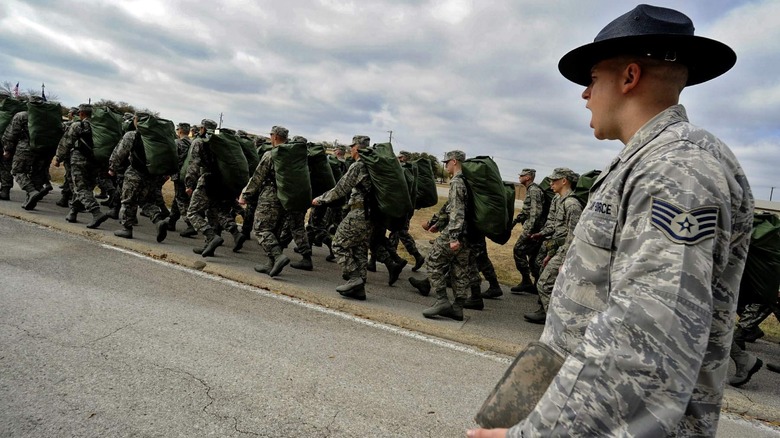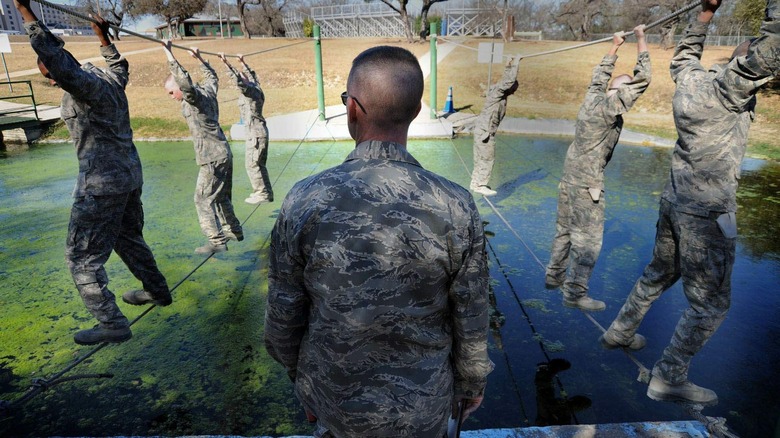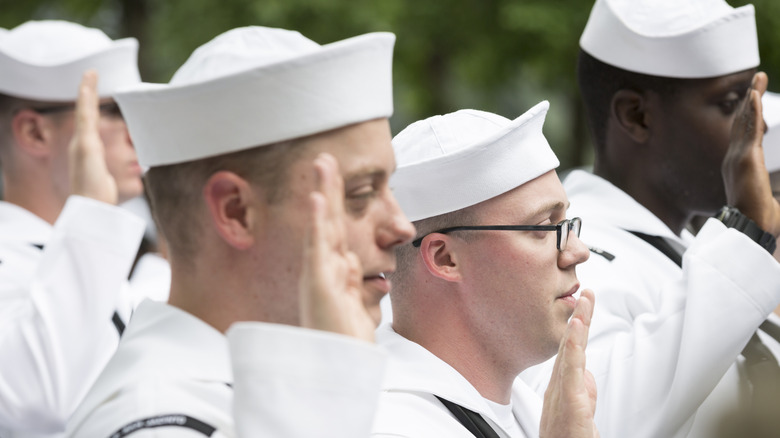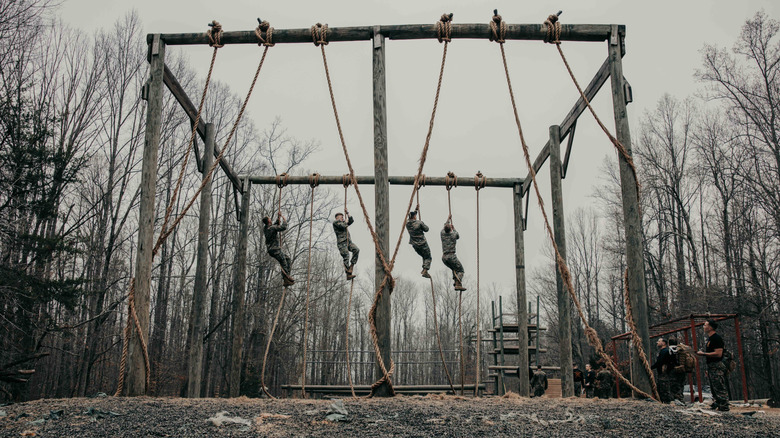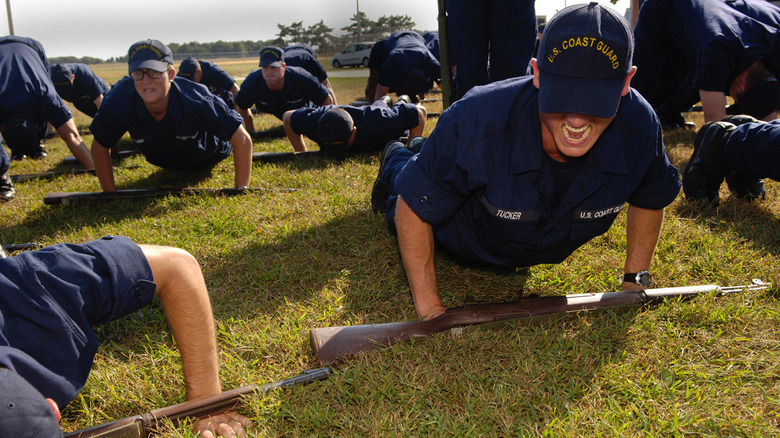US Military Branches Ranked From Easiest To Hardest To Get Into
If you want to serve your country, the military is a solid path. But which branch of the military is easiest? Well, we hate to break it to you, but the answer is none of them. There's no simple way to become a decorated military veteran. The truth is, not everyone can join the military, whether you have medical disqualifications or can't pass the necessary tests. Even if you don't plan on joining Delta Force or the Navy SEALs, boot camp or basic training followed by specialized training aren't exactly a walk in the park. Beyond that, it takes more than brawn to make it in the military, since applicants are required to take the Armed Services Vocational Aptitude Battery, or ASVAB, test, which results in an Armed Forces Qualification Test score.
The ASVAB has different completion requirements for each branch of the military, but that's just part of what it takes to become one of "America's Best," since each branch of the military has its own specific training programs. Let's go over those requirements and rank every branch of the U.S. military based on how hard they are to join. Remember, none of these are easy, but some tests are more difficult than others.
Army
To the public, the baseline military branch is the Army. Many people don't even know the difference between the different branches of the military and just conflate them all with the Army, kinda like how your aunt calls every video game a "Nintendo," or non-musicians who don't know the difference between a guitar and a bass. But I digress. Joining the army requires an ASVAB AFQT score of 31, which is the lowest of any branch of the military, but not by much.
Army basic training is a 10-week program that separates the wheat from the chaff, determining which prospective soldiers will actually make it into the ranks of U.S. ground forces. Before entering, some Army recruits take "prep" courses to boost their academic or physical fitness, and then it's 10 weeks of non-stop physical exercise, written tests, and basic training. Halfway through, recruits take on an exam called "The Hammer," an overnight in-the-field exercise meant to test their talents thus far. This is followed by a 48-hour exercise called "The Anvil," and then the final exam, known as "The Forge," that can last between three and four full days.
After all that, there's still the Army Combat Fitness Test, but if you've made it through The Forge, which can involve 46 miles of navigation while carrying a full loadout of standard issue equipment, the ACFT's two-mile run, planks, deadlifts, and other exercises don't seem so bad...
Air Force
The Air Force has the shortest basic military training period, at just 7.5 weeks, but that doesn't mean it's any less intense than its counterparts. Flying a plane, especially a fast fighter jet, requires peak physical conditioning. The countless support roles also require a high level of discipline. There's no way around it, if you want to be in the military, you're going to sweat. The Air Force needs an ASVAB score of 31 as well.
Air Force training culminates in the "Primary Agile Combat Employment Range Forward Operations Readiness Generation Exercise," better known as the PACER FORGE. This is a simulated deployment that puts recruits through a battery of exercises that put their training to the test, requiring teamwork, problem solving, and giving them a taste of what they might encounter during a real combat scenario. It's the kind of "final exam" that pushes recruits to their limits, allowing them to utilize what they've learned thus far and put their training into practical application.
At the end of it all, candidates are required to pass a physical fitness test, which consists of a minute of sit ups, a minute of pushups, and a 1.5-mile run. But after more than seven weeks of intense military training, you should be ready to meet that challenge.
Navy
The Navy has the second-highest ASVAB AFQT score requirement at 35. The Navy basic training program lasts for 10 weeks and naturally includes water-based training as well as tons of physical training, classroom learning, and the kind of "all-purpose training" that all recruits across the entire military are expected to go through.
For the Navy, the final exam is called Battle Stations aboard the USS Trayer, a simulator used in a 12-hour gauntlet that puts recruits' training to the ultimate test in a series of exercises designed to simulate real crises that can occur on a ship. Upon completion of this test, recruits are now officially Navy sailors. After this, they begin "A-School," more specialized training that prepares sailors for which of a wide variety of Navy jobs they might ultimately decide to pursue during their careers in the military.
Finally, all recruits must complete a final physical test before graduation, consisting of two minutes of pushups, a forearm plank, and a 1.5 mile run.
Marines
On the surface, the Marines might seem similar to the Army, but they serve different roles and have different training regimens to cover vastly different roles in modern warfare. To start, entry into the Marine Corps requires an AFQT score of at least 31, after that, 13 weeks of recruit training.
In terms of boot camp, the 13-week Marine Corps course is tremendously difficult. It all begins with the iconic "yellow footprints," where all recruits stand, pledge, and become part of "the Corps." Recruits are forbidden to use personal pronouns like "I" or "me," and are instead made to refer to themselves in the third person. Marine Corps training culminates in a final exam called "the "Crucible" — a 54-hour test that involves miles of marching and a nigh-endless barrage of tests designed to push every recruit to their limits. It ends with a nine-mile hike, after which the recruits are given their "Eagle, Globe, and Anchor" in a ritualistic ceremony signifying their transition from recruits to "the few, the proud, the Marines."
Coast Guard
Finally, we have the Coast Guard. The branch has a confusing setup wherein its mission is typically domestic, operating under the Department of Homeland Security while the others are strictly Defense Department. This is actually the most difficult branch of the military to get into. The Coast Guard is comparatively smaller and can be thus more selective about recruits. They're generally deployed on search-and-rescue missions within American waters. In any case, the ASVAB requirements for joining the Coast Guard are the highest of any branch of government, with high school graduates requiring a 40 or higher to qualify. But, as we all know by now, this test is just the tip of the iceberg.
Unlike the other branches, Coast Guard training includes a mandatory swim test, ensuring every recruit can handle themselves in the water.
Coast Guard training is an eight-week program and includes a mixture of paperwork, physical challenges, and classroom learning. The physical requirements include pushups and sit ups, as well as a 1.5 mile run, which is less than the two miles required by the Army, but still requires discipline. After all, if you're going to be rescuing people lost at sea or handling fallout from storms, hurricanes, and natural disasters, you'd better be able to carry your own weight. Most enemy combatants can't hit as hard as the ocean.
